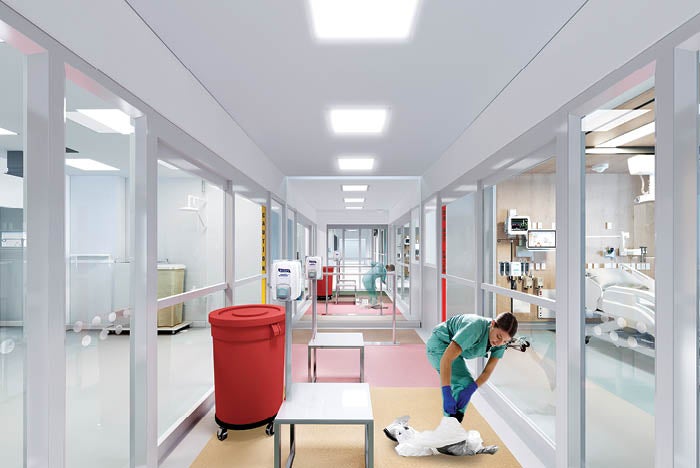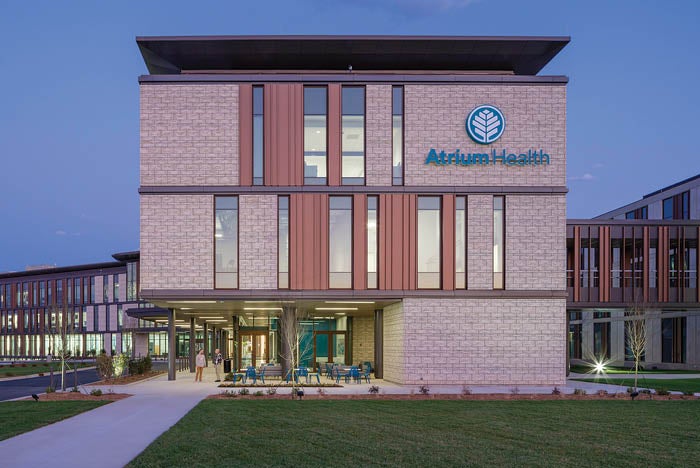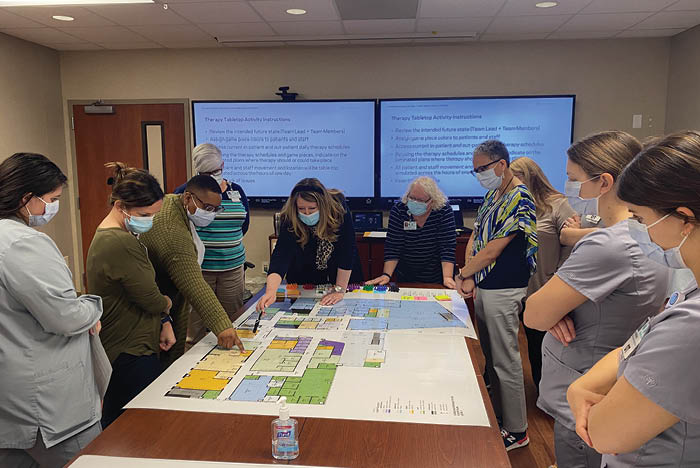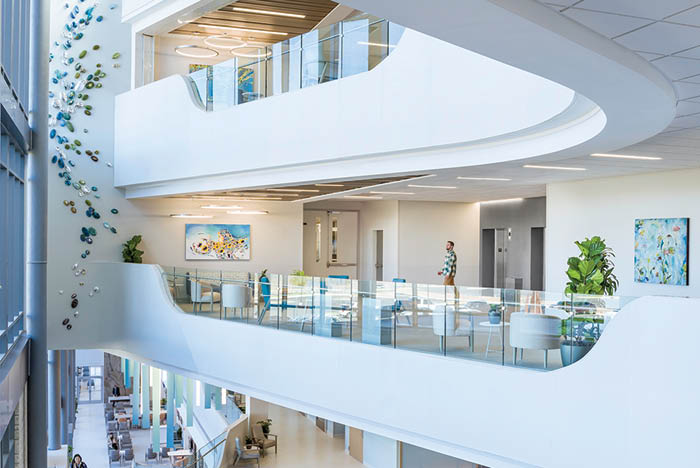Nurses provide essential design guidance

Through Lean design processes, collaboration with the interprofessional team at Monument Health Rapid City Hospital in Rapid City, S.D., led to a more streamlined registration area design in the lobby with open spaces that support the goal of visual and physical connectivity between key public areas.
Images by ©Attic Fire Photography
In her seven years as a trauma nurse, Nikki Cirrincione, R.N., NCIDQ, BSN, MIA, remembers working in patient rooms where she felt alone on an island.
Particularly in older facilities, patient rooms were often isolated from the main hub of activity, creating difficult, even dangerous, scenarios for nurses, says Cirrincione, who spent five years as a trauma nurse in Pittsburgh and two years as a travel nurse throughout California. She worked in six different health care facilities from 2008 to 2015.
“In some facilities, the environment created safety concerns for all the trauma nurses,” Cirrincione says. “I’ve seen co-workers get choked by patients. I had a schizophrenic patient throw a bedside table at me from across the room.”
Cirrincione quickly realized that certain design elements in the patient room were making an already difficult job even harder. Some rooms had blind corners, where patients could hide and jump out at nurses. Or the nurse’s computer was tucked in a corner, trapping the nurse in a small spot not facing the patient. And many patient rooms weren’t near the central nurses station, creating that alone-on-an-island feeling for caregivers.
The experience made one thing clear to Cirrincione. The nurses who spend endless hours in facilities caring for patients — often putting their lives on the line — deserve to be included in the design process.
She decided to make a difference. Cirrincione earned a master’s degree in interior architecture at Pittsburgh’s Chatham University in 2015.

Wayfinding and connectivity were important elements identified by the interdisciplinary teams at Monument Health Rapid City Hospital.
Image by ©Attic Fire Photography
In 2016, she joined the Los Angeles-based LEO A DALY architectural firm as a job captain and recently became a health care planner for Corgan Design, an architectural and design firm in Los Angeles. And she has branched out as a researcher, co-authoring papers including, “Preventing Emergency Department Violence through Design,” for the Journal of Emergency Nursing in 2018.
“I have had a lifelong passion for design, so this career allows me to use my nursing and design skills to help create safer environments not only for the patients, but for the hospital staff,” she says. “The voice of the nurse tends to get left behind.”
Forging a design path
While there are exceptions, traditionally, designers and architects have taken health care facility projects from conception to construction without seeking input from the nurses impacted by the designs. That is beginning to shift, but nurses are still struggling to make their voices heard.

The Monument Health Rapid City Hospital emergency department caregiver collaboration area was created as a response to the vision of a new, collaborative workflow developed by nurses and other members of the interprofessional care team.
Image by ©Attic Fire Photography
“Historically, or even recently, hospital design projects were created in a vacuum without input from nurses,” says Kate Newcomb-DeSanto, R.N., MSN, MSW, president of Connected Healthcare Resource Advisors in Philadelphia and a board member of the Nursing Institute for Healthcare Design (NIHD). “When designs are not efficient, nurses are asked to make things work, which they are accustomed to doing. Nurses are usually not people who complain a lot. They just consider it part of their jobs.”
While nurses may not always advocate for themselves, a new generation of nurses like Cirrincione and Newcomb-DeSanto are forging a path in the design world to give them a voice at the design table. The shift is reflected in the growth of NIHD, which is dedicated to integrating clinical expertise into the planning and design of health care environments. Founded in 2010, NIHD has approximately 150 members working as architects, designers, engineers and health care consultants. Approximately 70% of members are nurses (see sidebar on this page).
More architecture and consulting firms are employing nurses on their teams, and health care facilities are including clinical liaisons on design teams to advocate for the voice of the caregiver. The shift is rooted in factors including the realization that nurse input can prevent costly efficiency mistakes and improve staff and patient satisfaction. The nursing shortage that started well before the COVID-19 pandemic also is motivating health care to be proactive in understanding what nurses want with the goal of retaining them.
“Part of the reason we are having a nurse shortage is that nurses are overwhelmed and burned out,” Newcomb-DeSanto says. “We can make design changes that make their jobs more efficient, reduce steps and eliminate time-consuming workarounds. We need to create spaces where they can spread out and breathe, gather with colleagues, eat dinner and take a break from their workload.”
Critical input
Along with their role in the entire continuum of patient care, nurses have in-depth understanding of hospital workflow, staffing, facility processes and cost-related issues that tie into every area of design. Hospitals would be wise to tap that expertise, says Tammy Felker, R.N., AIA, ACHA, EDAC, LEED AP BD+C, NBBJ Architects, Seattle, who specializes in planning, programming and designing for health care facilities.
“As the primary care deliverers, it’s especially critical to understand the needs of nurses,” Felker says. “Nurses understand the complex ecosystem of a health care facility better than anyone else. They work in all departments in a variety of roles. Their voices should be heard early and often in the design process, not just at the end with the operationalization of the facility.”

These anteroom and patient room designs for highly contagious patients were part of a project for an undisclosed organization that required nurses to provide extensive input on how the layouts accommodated clinical equipment operations as well as personal protective equipment doffing.
Image by LEO A DALY
Felker says that programming and early planning were facilitated by nurses as an integral part of the design team for St. Michael Medical Center in Silverdale, Wash.
Likewise, nurse input was critical in shaping the Pavilion for Penn Medicine, a massive $1.6 billion, 1.5-million-square-foot facility that opened its doors in October 2021. As a clinical adviser on the PennFIRST design and construction team, Newcomb-DeSanto worked for seven years on the project that utilized full-scale mock-ups of spaces allowing nurses to simulate care and understand the impact of design. The team built half an entire patient floor out of Styrofoam to test design plans with staff, she says.
“The nursing staff provided input and shaped the outcome from top to bottom on everything from the bathroom location in the patient room, to workflows for things like on-time specimen delivery from operating rooms, to charting locations, footwall design, supply placement, patient servers and many more features,” says Newcomb-DeSanto, who began her career as a nurse at Penn Medicine in 2004.
Because nurses aren’t trained to read architectural plans or understand design drawings, mock-ups and simulation are effective tools to create a real-world experience for nurses, Felker says.

Clinicians were involved in the patient care spaces, clinical workflows and patient journey through the care process at Atrium Health Union West located in Stallings, N.C., where they also helped prioritize important design elements like access to exterior views and outdoor dining.
Images courtesy of Perkins&Will
“Early mock-ups with staff engagement provide ownership of the design by the staff and mitigate changes during construction,” Felker says. “It also allows them the opportunity for early training and education of peers.”
In designing Atrium Health Union West, in Stallings, a suburb of Charlotte, N.C., Sarah Francis, R.N., MSN, NEA-BC, EDAC, applied the Lean methodology and evidence-based design principles to engage front-line staff in the design development of the 150,000-square-foot facility that opened its doors in February 2022. Francis began her 14-year career at Atrium as a nurse, advancing to nurse manager and director of nursing services before accepting her current position as director of planning, design and construction.
Nurse input is critical to following the Lean design model used by many hospitals, which applies Lean ideas in health care to minimize waste with process improvements, which translates into a better patient and staff experience, says Francis, who earned her Evidence-Based Design Accreditation and Certification (EDAC) in 2019.

Images courtesy of Perkins&Will
“In following the Lean model, we go where the work is being done and examine workflows, workarounds and other processes to try and improve them for nurses and patients,” Francis says. “We need nurses at the table to explain how the design can make their jobs easier, even if we can save them a few steps during daily routines to ultimately spend more time with patients. Nurses also are safety experts, which is critical to design.”
For the project, designers took a standardized approach to the patient room, which offers the ability to use modular construction and prefabrication, making a seamless transition for nurses working between facilities. “Standardization allows for consistent workflows and patient experience between hospitals, which improves efficiency,” Francis says.
While including nurse input on a project is critical, architects and designers say multidisciplinary input across the board, including from clinicians, environmental services, engineers and administrators, also is necessary for a functional, efficient design that benefits patients and staff.
Building bridges
Because they have experience on both sides, designers and architects with nursing credentials say a big part of their role focuses on bridging gaps in communication.
When Misty Chambers, R.N., MSN, Assoc. AIA, EDAC, a clinical operations/design specialist at ESa, an architecture firm in Nashville, Tenn., approaches a new project, her nurse mindset is deep-seated in her design approach.

NBBJ nurses working with clinicians to provide a healing environment.
Image courtesy of NBBJ
Walking into a patient room, she sees design from a safety, function and infection prevention perspective. Caregivers need to wash their hands frequently, so sinks need to be convenient. Nurses need visual and physical access to patients, so features like bed placement and view windows are critical. Even the location of sharps containers impacts safety and can save a nurse time and steps.
“I help the design team think about the function and flow of health care space from a clinician’s perspective, which helps the team ask the right questions and address the client’s needs,” says Chambers. “Part of my role is focused on communication. A client may use terminology that means one thing in the clinical world and something else to the design team, so I’m there to bridge those gaps.”
Chambers, who was a nurse leader and facilities planning director at the Monroe Carell Jr. Children’s Hospital at Vanderbilt University before joining ESa in 2006, says her dual roles prompted one client to dub her an “archi-nurse.” Her recent projects at ESa include the Crystal Spring Tower at Carilion Roanoke Memorial Hospital in Roanoke, Va., and Monument Health Rapid City Hospital in Rapid City, S.D.
Other nurse designers also see their role as a critical link between the design and clinical staff. “I always say I see myself as a translator,” Cirrincione says. “Health care is its own animal, and architecture is its own world. I speak both languages.”
Francis uses her considerable experience on the clinical end and her talent as a communicator to inform her design role at Atrium. “I’m not an expert in design and construction,” she says. “I’m a bridge builder. I build a bridge between the design staff and the users on the clinical end. I have realistic conversations with both and advocate for the ‘must-haves’ for the clinical staff.”
A human touch
Nurse designers also have a feel for the interior and aesthetic features so critical to staff and patients, says Whitney Hendrickson, R.N., CHID, EDAC, LEED AP ID+C, a registered nurse for the past 16 years who worked on the early planning and user meetings on the Atrium project.
“I design from a human perspective, which is directly related to my background as a nurse,” Hendrickson says. “I pay attention to how things like signage, artwork and lighting can impact the overall experience.

An exterior waterfall at St. Michael Medical Center in Silverdale, Wash., was among the features influenced by NBBJ nurses.
Image courtesy of NBBJ
For example, in spaces where a provider might be having a sensitive conversation with a patient, I might try to incorporate natural light or find another way to make the setting more peaceful to lower stress. Focusing on the human experience comes from a place of empathy because, as a nurse, I’ve seen it.”
Felker, who specializes in designing spaces for behavioral health care patients, cites a quote from Winston Churchill as the basis for her design philosophy. “First we shape our buildings, and then they shape us.” The behavioral health facility can shape behaviors and experiences, she says.
“Noisy, crowded and institutional-feeling spaces can increase stress and agitation, leading to patients acting out,” Felker says. “Creating calming, supportive spaces that implement evidence-based design strategies like access to nature and daylight and lower social density can decrease stress and promote healing. Nurses understand this and can help guide the design team in planning the facility.”
Chambers, whose practice is strongly tied to evidence-based design research, says hospitals hoping to retain nurses should explore ways to improve their surroundings. “Research shows a correlation between nurse job satisfiers and design of the physical environment,” Chambers says.
Using their voices
While the future is brightening for nurses in terms of having clinical advocates on design teams, they also need to use their own voices more often, Newcomb-DeSanto says. Nurses are so good at workarounds and making the best of any situation, it’s difficult to make a case for change. “Often, a nurse’s work situation doesn’t improve unless something goes wrong,” she says. “And that’s not what designers want.
“Part of what nurses need to do in our design roles is to help health care systems and design teams to create a structure for integrating input from front-line workers, including nurses,” Newcomb-DeSanto says. “There needs to be a partnership between designers and the clinical side to make sure we understand each other’s goals. I’m here to give guidance and set priorities for both sides.”
Nurses blazing a path in the design world are making significant progress, but there is much work ahead of them, Felker says. “There is an increasing understanding of the value of caregivers’ input in design, but there is much more that can be gained,” she says.
Beth Burmahl is a freelance writer and regular Health Facilities Management contributor based in Carbon Cliff, Ill.





